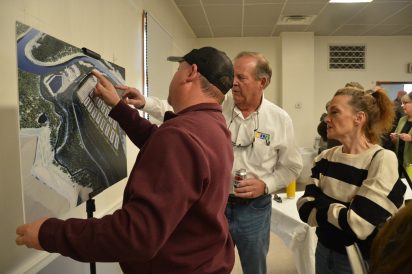Greene County residents voice concerns at data center open house

Residents near the area of a proposed data center complex in Greene County talked with local officials, as well as representatives from the power and water companies serving the site, at an open house on the project Tuesday night.
Dubbed Project Hummingbird, the complex will span 1,400 acres at the former Robena Mine site along the Monongahela River.
Power will come through two natural gas turbines to be installed on-site by Pittsburgh-based International Electric Power, which will generate 910 megawatts.
IEP is partnering with Bryn Mawr-based Essential Utilities, which is building a water treatment facility for the 18 million gallons a day used for the power generation facilities and the cooling systems for the data center.
IEP CEO Peter Dailey said the area’s natural gas resources and proximity to the river made it an attractive fit for data centers.
He said the company was investing $2 billion into the project, and anticipated the data center investment would be around $10 billion.
“Obviously, that’s a huge amount of capital to be invested in the region, and will be good for everyone, because it will lift all boats,” he said.
Bailey said IEP is in discussion with seven potential customers for the site, with a final one expected to be in place in the first quarter of 2026.
All the potential customers would be hyperscale centers, which use large arrays of server rooms for data-intensive tasks like cloud computing or artificial intelligence.
IEP estimates the project will create 1,000 to 1,500 jobs during construction. Once everything is up and running, there would be about 50 fulltime jobs with the power plant, and 12 to 20 full-time workers at the power plant. IEP said it planned to work with the Greene County Career & Technology Center for training for both construction and permanent jobs.
The turbines have been secured for delivery in 2028, and are anticipated to be operational in early 2029, Dailey said.
Emissions would be about a third of those at a coal-fired plant, said Trent Markell, an engineer with the project.
The plant has an estimated lifespan of 35 years, while the data center would have a 20-year tenant agreement, Dailey said.
Most attendees at the meeting were residents of Alicia, a small community on the river near the site.
They were largely skeptical of the promises made by the developers, worrying about the potential for noise and light pollution produced by the power plant.
Residents said the tightly connected community had offered them quiet, while the reclaimed coal dump site had also offered prime opportunities for hunting and fishing.
Pointing to a large rendering of the site, Tanner Barton pointed to the spot where he had his first successful hunt, which would fall within the footprint of the data center.
He also worried that none of the money generated would go to benefit the nearby community.
“It could be this big, beautiful thing that none of us wanted, but it’s apparently great,” he said. “They say it’s a spike in the revenue — good for the economy, but it’s all good for the investors and the politicians who made it happen.”
After an initial presentation, residents had extended conversations with company representatives at the site, as well as county officials.
Tom Barton guessed it would take him only about a minute on his four-wheeler to travel from his house to the power plant site. If you’d told him about the project five years ago, he said, “I would have sold my house.”
“I’m all for jobs, 100%, but for us, it’s right in our backyard,” he said. “That’s probably the hardest part for us, the light and the sound. A lot of that makes noise we don’t have right now.”
Commissioner Blair Zimmerman said as an economic generator for the county, “this is the best thing since the coal mines were here.”
“All the construction jobs, all the permanent jobs, the tax revenue … down the road, there’s going to be a lot of (tax) money for the Southeastern Greene School District,” he said.
Dailey said while there wasn’t a full assessment of how much property tax the property would generate, it would be well above the $100,000 per year currently.
Diane Price was concerned about the potential for emissions and the amount of light the project would shine on her house about 50 yards away.
“They gave us all their information, but they’re going to tell us anything we want to hear,” she said. “…It’s going to come whether we want it to or not.”
Responding to questions he’d gotten Tuesday, Dailey said the project would put in measures to keep the noise to the surrounding areas at around 55 decibels at the fence line. Regarding the light level, he said, “We’re not going to be shining lights in anybody’s windows.”
Dailey said Tuesday’s open house was the first of many sessions where the company would provide information about the project as it develops.
“We will be a great neighbor,” he said. “We’re not in the business of trying to pull anything over anybody’s eyes. So I think that this was a very instructive, positive discussion.”

